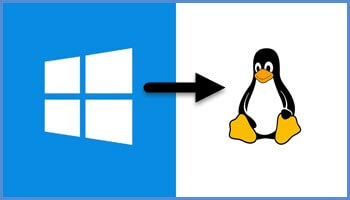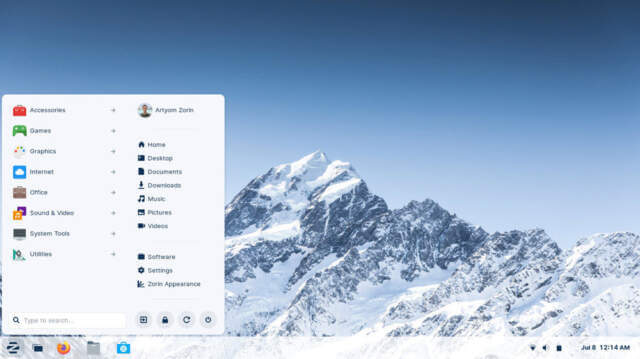We recently published an article setting out why Linux will never reach mainstream status: Why Linux Will Never Be Mainstream. While I do not pull back from that stance, I do consider Linux a very viable alternative to Windows under certain circumstances — for everyday computing, such as sending and receiving email, working with documents and images, surfing the web, etc., Linux can more than match it with Windows.
Glossary of Terms:
- Terminal: Linux’s alternative to Windows Command Prompt
- Distro: Short for “distribution” and an alternative term for operating system
- WINE: A Windows emulator which allows Linux users to run Windows applications
The Stigma Of The Linux Terminal
There was a time when the “Terminal” was required to achieve just about everything in Linux, even the simplest of operations. Unfortunately, this stigma has stuck and still puts many people off from making the change. I say “unfortunately” because, with the most popular Linux distros, this is definitely no longer the case. Over the past decade, these distros have all but done away with the need to use the Terminal and are pretty much 100% GUI (Graphical User Interface) driven. Which means, the user simply clicks interface elements to get things done, in much the same way as they would in Windows.
Probably the most significant consideration for existing Windows users when looking to transition to Linux is familiarity — the devil you know. However, Linux developers have also recognized this important element and many of the modern Linux distros are now very similar to Windows. Here then are three distros that are closest to the look and feel of Windows.
Zorin OS
Zorin OS is specifically designed to look and feel like Windows and, with its Look Changer feature, you can choose between a Windows 7 or XP lookalike. Zorin also comes with WINE (Windows emulator) pre-installed by default. If familiarity is the main requisite, then Zorin OS is definitely well worth checking out.
Minimum System Requirements:
- CPU: 1 GHz Dual-Core – Intel/AMD 64-bit processor
- RAM: 2 GB
- Storage: 15 GB
- Display: 1024 × 768 resolution
Linux Mint
Linux Mint comes in three different desktop environments: Cinnamon, MATE, and Xfce. Read about the differences here: Linux Mint Editions. Cinnamon is the most popular and also most like Windows so, for the purpose of this exercise, I’m suggesting you go with the Cinnamon edition.
While the Cinnamon Mint desktop very much resembles Windows you will find quite a few differences in the navigation system. It’s a pretty short learning curve though and once you get the hang of it you will feel right at home.
Minimum System Requirements:
- 2GB RAM (4GB recommended for comfortable usage)
- 20GB of disk space (100GB recommended)
- 1024×768 resolution
Kubuntu
Kubuntu is arguably the least like Windows but it is close enough and comes with a very strong feature set. If you’re looking for extreme configurability and a modern feel then Kubuntu is probably your best bet. Kubuntu ships with the KDE Plasma desktop which features animations (they can be turned off) and is consequently not the most lightweight of Linux distros. It should, however, run perfectly well on quite modern machines.
Minimum System Requirements:
- 2 GHz dual-core processor
- 4 GB RAM (system memory)
- 25 GB of hard drive space
- VGA capable of 1024×768 screen resolution
SPECIAL MENTIONS:
- Linux Lite: For older machines with limited resources. Beginner friendly, closely resembles the Windows 7 desktop
- ReactOS: The only non-Linux Windows alternative. ReactOS has been under development for a very long time (since 1996) and is still in Alpha mode which means it is not yet suitable for general use. You’ll see ReactOS mentioned in lists of ‘best Windows alternatives’ but, as I mentioned, it is not yet suitable for general use
BOTTOM LINE:
All three distros included here will do a fine job as a Windows alternative. Although they all look very similar to the Windows desktop — complete with Taskbar, Start menu, and system tray — there are navigational differences that involve a short learning curve. If familiarity is paramount, I would suggest Zorin OS. Linux Mint is an elegant and reliable Windows alternative — and my personal favorite. Kubuntu is for those looking for a modern and aesthetically pleasing experience.
—




Hello Jim,
Could DCT put an article about Linux WINE in the queue for us Windows users who may be considering a move to Linux, but are concerned about what Windows apps may be able to function properly (and reliably) under Linux.
Many thanks in advance.
Stay well, safe — and DRY!
Cheers,
AJ
Hi AJ,
Trouble is, as far as I am aware, there is no definitive list of Windows software that works in WINE. Even when Windows software is reported to work in WINE, it might require additional configuration or might not fully work properly. It’s all a matter of trial and error.
The best approach would be to make enquiries about a specific Windows software on the WINE forum: https://forum.winehq.org/viewforum.php?f=2
I am unaffected by the floods, thankfully. Appreciate the thought.
Cheers mate… Jim
Thanks, Jim; very glad to hear that you’re not affected by the flooding!!
So, with respect to the uncertainties of WINE, that would imply employing a [free] virtual machine, such as VirtualBox, VMware Player, or KVM — assuming a Linux box with sufficient resources (CPU & RAM), of course.
Would that have any effect on your choices of Linux distros?
All the best!
Cheers,
AJ
“Would that have any effect on your choices of Linux distros?”
No, not really, they’ll all run a VM, no problem. In my opinion, a VM is a better option than WINE but, of course, unless the user has a Windows activation key, it would be an non-activated copy of Windows. The only real drawback there would be no personalization options which shouldn’t present a huge problem.
Hi Jim,
I’ve been flirting with Linux for a good few years. I even downloaded one and paid for a wine which didn’t work in one of my windows sulks.
I did think of trying Zorin because it includes a wine but on checking the website there is no list of compatible programs and the wine only seems to be included in the PRO version. At £39GBP (68.25 Austrailian) it’s a little out of my (pension) price range for a punt.
Charging for open source Linux distros has been going on for ages but this seems a bit high. Perhaps they only charge the British…..
Hey Jonathan,
I didn’t realize that WINE was only pre-installed in the Pro edition, it isn’t mentioned in Zorin’s feature comparison chart. Sorry about that, my bad.
I’ve only ever installed Zorin’s free edition and, I agree, the Pro edition is a tad pricey… especially when the free edition (and other free Linux distros) will do the job nicely.
I was a little shocked and didn’t do my homework fully.
The price was not what I posted but had to have VAT added at the checkout.
£39GBP becomes £46.80 (56.16 Austrailian).
For me it’s just one Game (Civilization 5) that keeps me tied to Windows. The last time I tried with a wine emulator that I paid for it was even listed as compatible and didn’t work (pre Steam and a couple of updates ago) The then seller stopped answering emails when their instructions didn’t work N.B.Not Zorin. Makes me a bit cautious but still prepared to take a punt IF things are displayed up front by the seller.
I’ll keep my eyes peeled for any info on Civ 5 compatibility online But am too busy to take on another ‘Hobby’ (Linux). I just want stuff to work.
Thanks again for all the hard work and information you hand to all us lazy gits for free!
Yes, well, yours is a typical case of why users are reluctant to move from Windows to Linux…. there always seems to be at least one must-have game or application that is specific to Windows with no viable alternative available for Linux.
“I just want stuff to work“.
Precisely!
Zorin 15.3 and 15.3 lite are still available for 32bit processors so it is a viable alternative. I currently have lite installed on a 15 year old Dell laptop and it runs very well. The lite version is not as feature rich, but has all of the must haves.
Good to know Edward. Thanks for the info, appreciated.
I have two computers. One runs Windows 10 & I use this for CAD. The old problem CAD is designed around Windows programs. Worse My printer is a Ricoh SP211 Laser printer.
My other Computer runs Linux Mate. Ricoh SP211 printers are not supported on Linux machines. I have been running Linux for a number of years. I tried to run Wine with a Windows Cad Program. Too many hang-ups back then & given the cost of CAD programs plus my SP211 not running on my Linux Machine. (I think this is the fourth version of mate that I am now using). It seems more logical to stay with the one Windows 10 machine. Both machine run on good processors with SSD & 8G of ram. So I am happy with things as they are. The Windows 10 Machine is slightly faster than the Linux Mate one particularly during start up.
Any articles re: how to accomplish certain tasks in Mint Cinnamon compared how you do them in Windows 7 or w10? MS did that for Wordperfect users transitioning to Word. in a chart form. Thanks.
Hey Charles,
Honestly, there is not that much difference between navigating around Linux and Windows. Popular distros come with a start menu, including shortcuts to settings and options.
That said, yes, I’ll put something together covering Mint Cinnamon, no problem. It might be in a little while though, I am away from home at the moment as my lovely wife is recovering in hospital from major surgery. I’ll sort something out when we get back home.